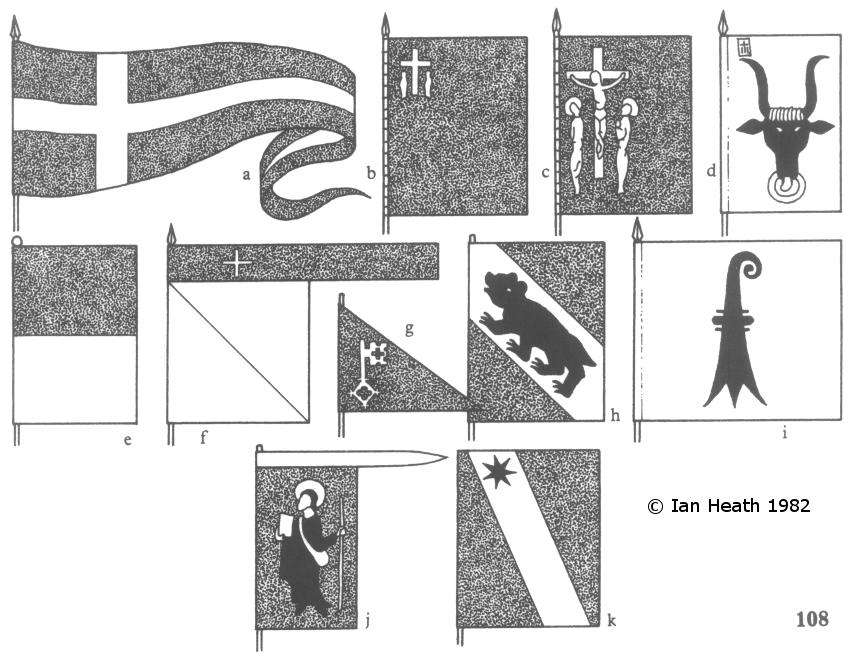SWISS FLAGS An extract from Armies of the Middle Ages, volume 1 by Ian Heath
| |
SWISS FLAGS An extract from Armies of the Middle Ages, volume 1 by Ian Heath
| |
108. SWISS FLAGS
This selection is based on contemporary or near-contemporary illustrations and actual surviving examples.
108a is the Confederate flag, a white cross on red, which came into use in the 15th century. It appears to have derived from the Schwyz cantonal flag, two versions of which are shown in b and c. The Schwyz flag was plain red in the 14th century, but by the time of the Burgundian Wars a crucifixion scene was normally embroidered in the top corner, this sometimes being replaced by a white cross after 1475. In 108c the figure on the left wears blue, that on the right wears green, the cross, haloes and Christ's loincloth are gold, and faces, hands and the figure of Christ are white. A second flag, red with a white cross like the Confederate flag, was carried on campaign in foreign lands.
108d is the cantonal flag (Landesbanner) of Uri, which was yellow with a black bull's head with red tongue, nose-ring and eyes. The small device at top left was a resurrection scene, briefly abandoned in the late-14th and early-15th centuries in favour of a small white cross between the horns.
108e is the simple red over white flag of the third Forest Canton, Unterwalden. The flags of Solothurn and Obwalden were identical, though the latter at least sometimes bore a white cross in the upper portion. Fribourg's flag took the same form but was black over white, while Lucerne's was white over blue.
108f is another white over blue flag, this time Zurich's. This version, with a red schwenkel and white cross, was carried during the Burgundian Wars. Yet another blue and white flag was that of Zug, where the field was divided horizontally into 3, the stripes being white/blue/white.
108h is the flag of Berne, which was red with a black bear on a diagonal yellow band. A black bear also appeared on Appenzell's Landesbanner, standing rampant with red claws, eyes, lips, tongue and insides of ears, on a white field. Another flag with an animal device was that of Schaffhausen, which was yellow with a black ram.
108g is a fähnlein ('small flag' see page 40) bearing Nidwalden's device of a gold key on red, carried at Sempach. A 15th century example has a key device with 2 sets of wards, opposite one another, in silver alongside a small white cross.
The device on 108i is a bishop's crozier. This was the flag of Basle, which was white with the crozier in either red or black.
108j is the flag of Glarus as carried at Naefels. It is red with the monk in black with white face and hands, brown scrip-bag and staff, and gold bible and halo. The schwenkel is white.
108k is Thun's flag. This was red with a white diagonal stripe and a 7-pointed black star, the star being changed to gold after 1476. The surviving example carried at Morat differs only in having a white schwenkel.
The staffs of Swiss flags were usually painted in the cantonal colours for example, Schilling's pictures show Confederate and Schwyzer flags with red staffs, those of Unterwalden and Zug with staffs painted in red/white and blue/white diagonal stripes, and those of Lucerne and Uri painted blue and yellow respectively.
It should be noted that at Nancy, where they were fighting as mercenaries, the Swiss did not carry their cantonal flags.